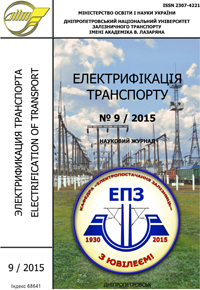Alternative heating laboratories the higher education institution
DOI:
https://doi.org/10.15802/etr.v0i9.51734Keywords:
electric academic laboratories, the heat balance equation facilities, ventilation, power infrared heater, electric heating benefitsAbstract
Heating is an important factor in ensuring the right microclimate in any room, including educational laboratories university. Microclimate has a significant impact on the productivity of students, teachers and technicians. The main factor is the microclimate temperature in the room. This paper studies to obtain baseline data required to replace traditional water heating in the laboratory for electric. This should be supported by a given temperature. The method of ventilation facilities, types of electric heaters, volume of incoming and exhaust air, at which temperature the laboratory will S according to your requirements.°provide 18 Electric space heating is more convenient to use, more comfortable and cheaper cost compared to the water systems in which heat is produced by burning fuel in boilers. To achieve goals and meet the challenges of the heat balance equation composed laboratory facilities, to which fulfilled the necessary research. The article offers educational laboratory electric system as an alternative to the existing centralized water heating using gas in the central boiler house in the cold and transitional seasons. As heating devices offers modern infrared heaters. Heat balance equation takes into account the parameters of a real educational laboratory. It is proposed to equip a laboratory mechanical supply and exhaust ventilation system. Scientific novelty of the proposed method of determining the amount (weight) of the supply and exhaust air for a given temperature in the laboratory study using electric heaters. The practical significance lies in the fact that the use of electric heating allows to improve the microclimate in the laboratory operating costs. Past studies can determine the initial parameters for automation of electric heating systems laboratories in order to maintain the desired temperature. It is recommended as an alternative to electric heating radiator-water.References
Курсовое и дипломное проектирование гражданских и промышленных зданий / В. П. Титов, Э. В. Сазонов, Ю. С. Краснов, В. И. Новожилов. – М.: Стройиздат, 1985. – 208 с.
Державні будівельні норми України. Будинки і споруди навчальних закладів: ДБН В2.2-3-97. – К.: Держкоммістобудування України, 1997. – 90 с.
Технические данные вентиляторов осевых ВО-6-300, ВО-14-320 [Электронный ресурс]. – Режим доступа: http://www.ooovv.ru/ventilyaciya/
texnicheskie-dannye-ventilyatorov-osevyx.html.
Виды и типы вентиляторов [Электронный ресурс]. – Режим доступа: http://www.fanner.ru/vidy-ventilyatorov.
Потужність нагрівача [Електронний ресурс] . – Режим доступу: http://www.informteh.ru/
sistemi_ventiljacii/rasch http://et_ ventiljacii/.
Системы притяжной и вытяжной вентиляции [Электронный ресурс]. – Режим доступа: http://www.clim-art. ru/ventilation/pritochno-vityazhnaya/.
Питома вага, густина повітря [Електронний ресурс]. – Режим доступу: http://www.about-air.ru/svojstva-vozduha/plotnost- vozduha/ plotnost- vozduha-pri-noormalnyh-usloviyah.html.
Аэродинамические коэффициенты [Электронный ресурс]. – Режим доступа: http://www.bibliotekar.ru/otoplenie-ventilyacia/75.html.
Державні будівельні норми України. Опалення, вентиляція та кондиціювання: ДБН В2.5-67:2013. – К.: Мінрегіон України, 2013. –149 с.
Маренич, О. Л. Экономия электроэнергии при ремонте подвижного состава железных дорог / О. Л. Маренич, О. О. Маренич // Трансбалтика 2009 (28.05-29.05.2009): сборник материалов ХІІ международной конференции. – Рига, 2009.
REFERENCES
Titov V. P., Sazonov E. V., Krasnov Y. S., Novozhilov V. I. Cursovoye i diplomnoye proektirovaniye grajdanskikh i promishlennykh zdaniy [Course and diploma project for civil and industrial buildings]. Мoscow, Stroyizdat Publ., 1985. 208 p.
Derzhavny budivelny normy Ukrainy. Budinky і sporudy navchalnikh zakladiv: DBN V2.2-3-97. [State building standards of Ukraine. Buildings and edifices of educational institutions: DBN V2.2-3-97]. Kyiv, State committee of the city building of Ukraine Publ., 1997. 90 p.
Tekhnicheskiye danniye ventilyatorov osevikh VО-6-300, VО-14-320 [Technical information of axial ventilators VО-6-300, VО-14-320]. Available at: http://www.ooo-vv.ru/ventilyaciya/texnicheskie-dannye-ventilyatorov-osevyx.html.3.
Vidy i tipy ventilyatorov [Kinds and types of ventilators]. Available at: http://www.fanner.ru/vidy-ventilyatorov.
Potuzhnist nagrivcha [Capacity of heating apparatus]. Available at: http://www.informteh.ru/
sistemi_ventiljacii/raschet_ ventiljacii/.
Sistemy prityazhnoy i vityazhnoy ventilyacii [Systems of supply and exhaust ventilation]. Available at: http://www.clim-art. ru/ventilation/pritochno-vityazhnaya/.
Pitoma vaga, hustina povitrya [Specific air weight and density]. Available at: http://www.about-air.ru/svojstva-vozduha/plotnost- vozduha/ plotnost- vozduha-pri-noormalnyh-usloviyah.html.
Aerodinamicheskiye koefficienty [Aerodynamic coefficients]. Available at: http://www.bibliotekar.ru/
otoplenie-ventilyacia/75.html.
Derzhavny budivelny normy Ukrainy. Opalennya, ventilyacya ta condiciyuvannya: DBN В2.5-67:2013. [State building standards of Ukraine. Heating, ventilation and conditioning: DBN В2.5-67:201]. Кyiv, Ministry of regions of Ukraine Publ., 2013. 149 p.
Marenych O. L., Marenych O. O. Ekonomiya elektroenergii pri remonte podvizhnogo sostava zheleznikh dorog [Energy savings in the repair of railway rolling stock]. Sbornik materialov XІІ mezhdunarodnoy konferentsii «Transbaltika 2009» (28.05-29.05.2009) [Collection of materials of the International Conference «TransBaltika 2009»]. Riga, 2009.
Downloads
Published
Issue
Section
License
При направленні статті в редакцію, автор гарантує, що стаття надається для публікації уперше і раніше не була опублікована в інших виданнях повністю або частково.
Підписанням ліцензійного договору автор(и) підтверджує(ють), що має(ють) виняткове авторське право на статтю і передає(ють) невиняткові права на свою статтю видавництву журналу «Електрифікація транспорту» для публікації в черговому номері журналу. Автор(и) так само дає(ють) згоду на передачу і розміщення електронної версії своєї статті на сайтах баз даних, створюваних і поширюваних через Інтернет.
